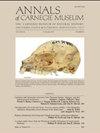New Primitive Caseid (Synapsida, Caseasauria) from the Early Permian of Germany
IF 0.9
4区 地球科学
Q4 PALEONTOLOGY
引用次数: 11
Abstract
ABSTRACT A new genus and species of a basal synapsid Caseidae, Martensius bromackerensis, is described based on four partial to nearly complete mostly articulated skeletons that provide a comprehensive knowledge of the skeletal morphology. All four specimens were collected from a single site, the Bromacker quarry, in the Lower Permian Artinskian Tambach Formation, Germany. The Bromacker caseid is the first to be reported from Germany and can be easily distinguished from all other caseids based on substantial lists of autapomorphic and plesiomorphic characters. Of the four caseid specimens only the smallest, a juvenile, and the largest, an adult designated as the holotype, are nearly complete, articulated, and possess skull material: in the juvenile a small partially articulated portion of the skull, and in the adult a nearly complete but dorsoventrally crushed skull. The two specimens are distinguished from one another by features attributed to different ontogenetic stages of development, which include skeletal ossification, proportional dimensions of elements, and most interestingly marginal dentitions. The last category includes a feature unique among caseids of an ontogenetic change in the dentition from insectivorous in the juvenile specimen to what is believed to be an omnivorous dentition in the adult. A phylogenetic analysis posits the Late Pennsylvanian Eocasea martini Reisz and Fröbisch, 2014, as the basalmost member of the monophyletic Caseidae and the later occurring middle Early Permian Bromacker caseid as the sister taxon of the remaining late Early and Middle Permian members of the clade. This series of relationships parallels a proposed chronology of evolutionary changes in the dentitions and associated diets of caseids.德国早二叠世新原始病例门(新门,病例门)
摘要基于四个部分到近乎完整的多关节骨骼,描述了一种基底突触类Caseidae的新属和新种Martensius bromackerensis,这些骨骼提供了骨骼形态学的全面知识。这四个标本都是在德国下二叠纪Artinskian Tambach地层的Bromacker采石场采集的。Bromacker病例是第一个在德国报道的病例,根据大量的自形和半形特征,可以很容易地与所有其他病例区分开来。在四个病例标本中,只有最小的,幼年的,和最大的,被称为完整型的成年的,几乎是完整的,铰接的,并拥有头骨材料:在幼年的头骨中有一小部分铰接的部分,在成年的头骨中有一个几乎完整的,但背腹破碎的头骨。这两个标本的不同之处在于不同的个体发育阶段,包括骨骼骨化、元素的比例尺寸和最有趣的边缘牙列。最后一类包括一个独特的特征,在牙列的个体发生变化的案例中,从幼年标本的食虫到成年标本的杂食性牙列。系统发育分析认为,晚宾夕法尼亚Eocasea martini Reisz和Fröbisch, 2014,是单系Caseidae的基础成员,晚出现的早二叠世中期Bromacker caseid是该分支剩余的早二叠世晚期和中二叠世成员的姐妹分类单元。这一系列的关系与提出的牙列进化变化的年表和caseids的相关饮食相似。
本文章由计算机程序翻译,如有差异,请以英文原文为准。
求助全文
约1分钟内获得全文
求助全文
来源期刊

Annals of Carnegie Museum
综合性期刊-动物学
CiteScore
2.50
自引率
18.20%
发文量
4
审稿时长
>12 weeks
期刊介绍:
Annals of Carnegie Museum is a quarterly journal that publishes peer-reviewed short and medium-length original scientific contributions in organismal biology, earth sciences, and anthropology, in 40 by 52.5 pica format (168 by 220 mm or 6-5/8 by 8-5/8 inches). Subject matter must be relevant to Carnegie Museum of Natural History scientific sections or Powdermill Nature Reserve (PNR), preferably with connection to the Carnegie collection and/or personnel. Carnegie Museum staff and research associates receive publication priority, but others are encouraged to submit papers, especially those manuscripts explicitly based on the Carnegie collection.
 求助内容:
求助内容: 应助结果提醒方式:
应助结果提醒方式:


